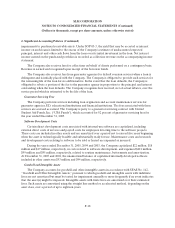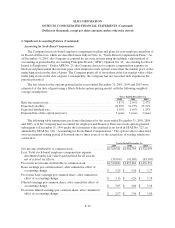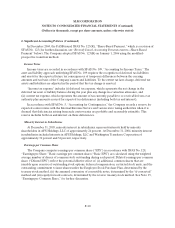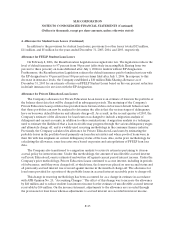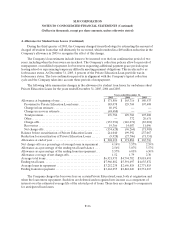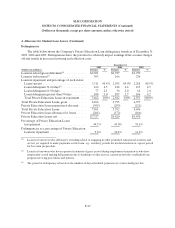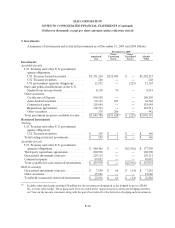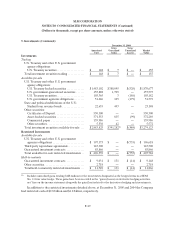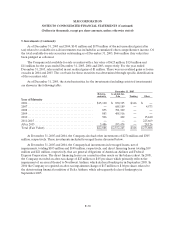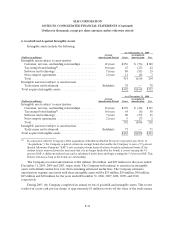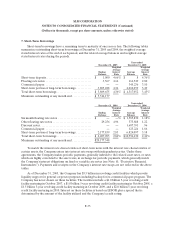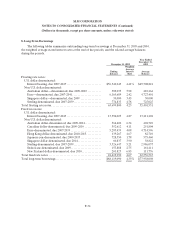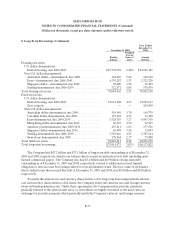Sallie Mae 2005 Annual Report Download - page 147
Download and view the complete annual report
Please find page 147 of the 2005 Sallie Mae annual report below. You can navigate through the pages in the report by either clicking on the pages listed below, or by using the keyword search tool below to find specific information within the annual report.SLM CORPORATION
NOTES TO CONSOLIDATED FINANCIAL STATEMENTS (Continued)
(Dollars in thousands, except per share amounts, unless otherwise stated)
F-25
4. Allowance for Student Loan Losses (Continued)
In addition to the provisions for student loan losses, provisions for other losses totaled $15 million,
$11 million, and $5 million for the years ended December 31, 2005, 2004, and 2003, respectively.
Allowance for FFELP Student Loan Losses
On February 8, 2006, the Reauthorization Legislation was signed into law. The legislation reduces the
level of default insurance to 97 percent from 98 percent (effectively increasing Risk Sharing from two
percent to three percent) on loans disbursed after July 1, 2006 for lenders without EP designation.
Furthermore, the Reauthorization Legislation reduces the default insurance paid to lenders/servicers with
the EP designation to 99 percent from 100 percent on claims filed after July 1, 2006. In response to this
decrease in insurance levels, the Company established a $10 million Risk-Sharing allowance as of
December 31, 2005 for an estimate of losses on FFELP Student Loans based on the one percent reduction
in default insurance for servicers with the EP designation.
Allowance for Private Education Loan Losses
The Company’s allowance for Private Education Loan losses is an estimate of losses in the portfolio at
the balance sheet date that will be charged off in subsequent periods. The maturing of the Company’s
Private Education Loan portfolios has provided more historical data on borrower default behavior such
that those portfolios can now be analyzed to determine the effects that the various stages of delinquency
have on borrower default behavior and ultimate charge-off. As a result, in the second quarter of 2005, the
Company’s estimate of the allowance for loan losses was changed to include a migration analysis of
delinquent and current accounts, in addition to other considerations. A migration analysis is a technique
used to estimate the likelihood that a loan receivable may progress through the various delinquency stages
and ultimately charge off, and is a widely used reserving methodology in the consumer finance industry.
Previously, the Company calculated its allowance for Private Education Loan losses by estimating the
probable losses in the portfolio based primarily on loan characteristics and where pools of loans were in
their life with less emphasis on current delinquency status of the loan. Also, in the prior methodology for
calculating the allowance, some loss rates were based on proxies and extrapolations of FFELP loan loss
data.
The Company also transitioned to a migration analysis to revise its estimates pertaining to its non-
accrual policy for interest income. Under this methodology, the amount of uncollectible accrued interest
on Private Education Loans is estimated and written off against current period interest income. Under the
Company’s prior methodology, Private Education Loans continued to accrue interest, including in periods
of forbearance, until they were charged off, at which time, the loans were placed on non-accrual status and
all previously accrued interest was reversed against income in the month of charge-off. The allowance for
loan losses provided for a portion of the probable losses in accrued interest receivable prior to charge-off.
This change in reserving methodology has been accounted for as a change in estimate in accordance
with APB Opinion No. 20, “Accounting Changes.” The effect of this change was to increase the allowance
by $40 million and to reduce student loan interest income for the estimate of uncollectible accrued interest
receivable by $14 million. On the income statement, adjustments to the allowance are recorded through
the provisions for loan losses whereas adjustments to accrued interest are recorded in interest income.





